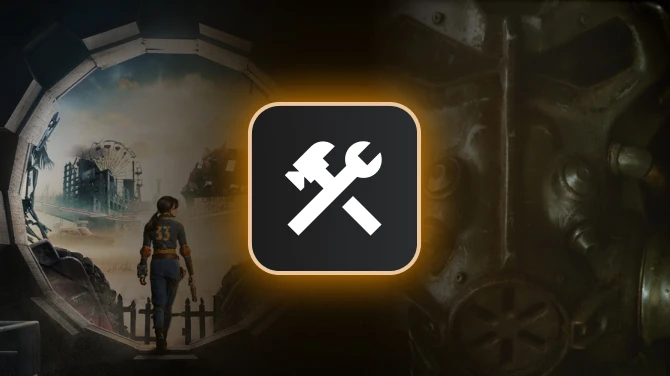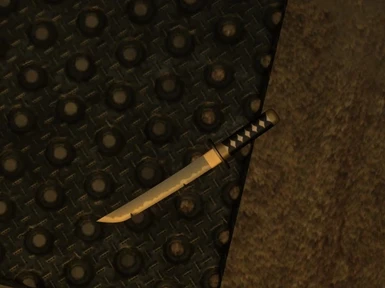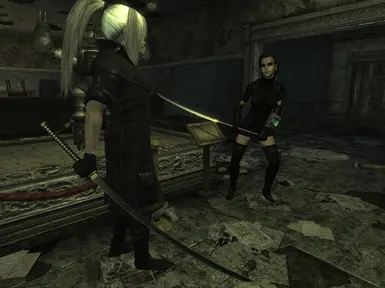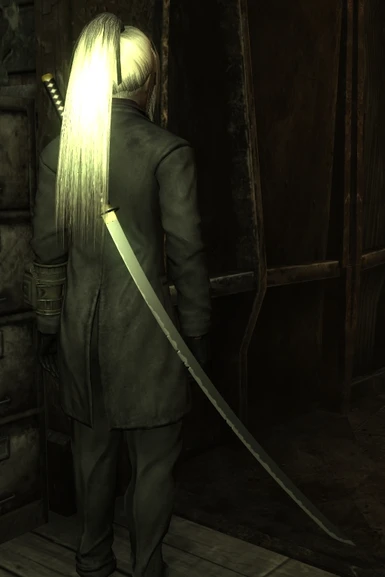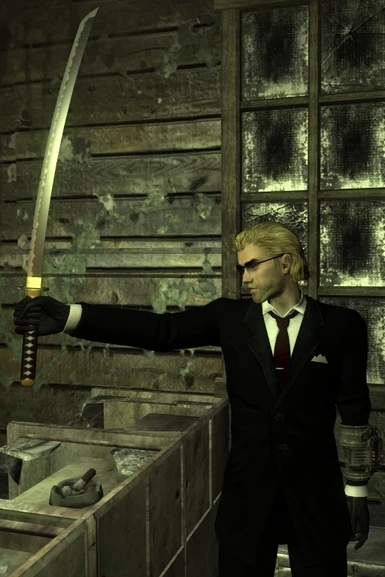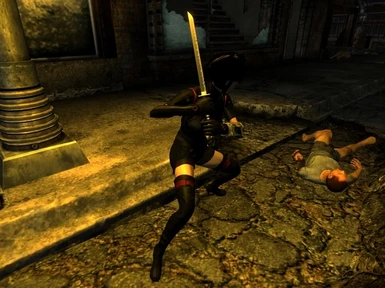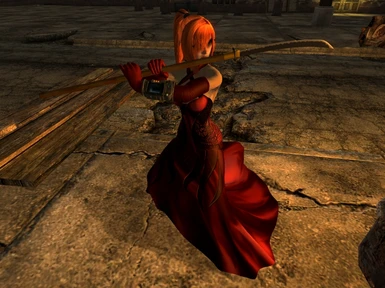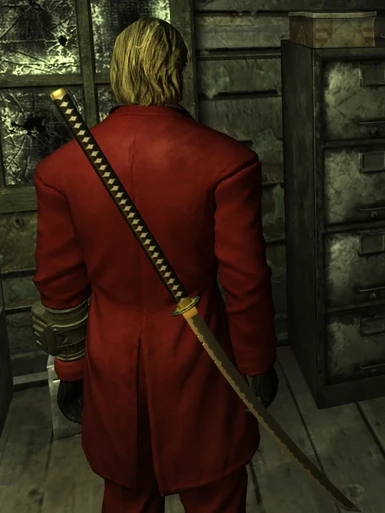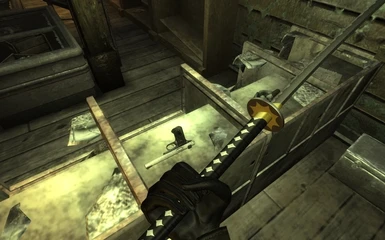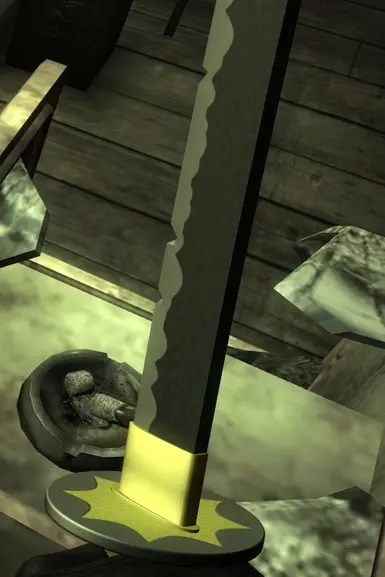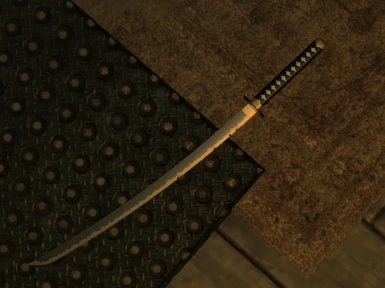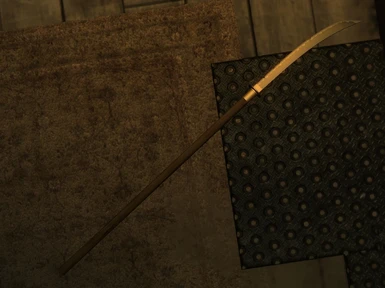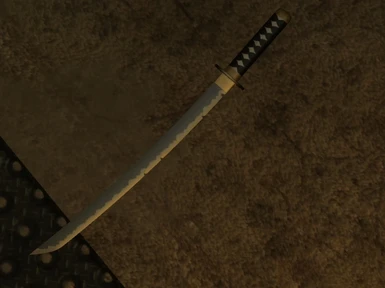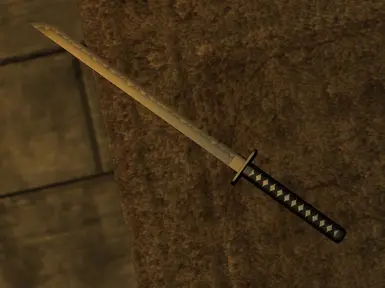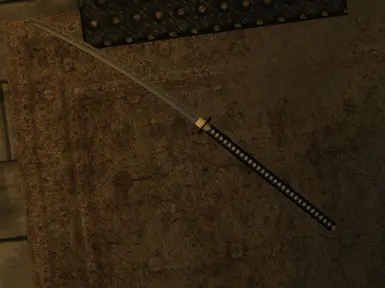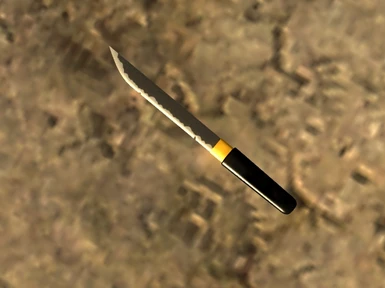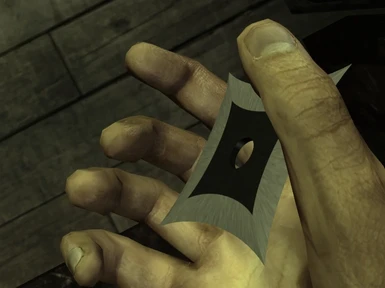About this mod
9 fine, folded-steel, differentially hardened, japanese weapons
- Permissions and credits
WHAT IT DOES
It adds a few Edo era Japanese weapons, because every game needs a good katana and derivatives ;) However, funnily enough, it is canon-friendly, as Fallout 2 did have a wakizashi blade as a playable weapon and the Fallout 3 DLC adds a katana.
The weapons ARE powerful, but need 100 skill. I.e., the damage and accuracy start lower, but increase as your skill increases, all the way to 100. I.e., they more or less grow with you as you level up and advance your melee skill.
The blades are made in hira-zukuri style, which is to say: flat, without a raised ridge line. Although this is more common for tanto, there are historical katanas built in this style.
They are made of folded steel (hence the metal pattern), differentially hardened (hence the traditional white hamon along the edge), and as shiny and polished as the art of sword polishing historically got in this period. We're talking whole dynasties of specialized sword-polisher craftsmen. They do however have their fair share of nicks in the edge, because we're talking weapons used in battle, not museum pieces.
The folded or pattern welded steel is sometimes incorrectly called "Damascus steel", but that's incorrect. The real Damascus steel is Wootz, an alloy where bands of high-carbon steel precipitate naturally during tempering. Japanese swords are not real Damascus steel, but really pattern welded steel. You know, folded and hammered repeatedly.
Note that when discussing the dimesions below 1 shaku is very very close to 1 foot, so you can take the dimensions pretty much 1 to 1 when comparing to japanese standards.
The weapons are:
1. A katana. It's got an approximately 2.5 shaku long blade, which actually makes it a fairly long katana. Most are under 2.4 shaku, some significantly under. There is no fixed length though. To be a proper katana, it can be anywhere between 2 shaku (under that, it becomes a wakizashi), and 3 shaku (over 3 shaku, it becomes an odachi.) The blade is about 1.35 inch wide and a quarter of an inch thick, both of which are fairly average. And, of course, it sports a gentle curve, largely because that's what happens when you differentially harden a single-edge sword.
The tsuba (guard) is based on a historical Edo era tsuba, made of steel with inlaid gold. The tsuka (handle) sports the traditional silk wrap that Japanese swords are well known for.
2. A wakizashi. It's got a blade that's just slightly under 2 shaku in length, which means it barely misses qualifying as a katana itself. Blade width and thickness are just like for the katana above.
It has the same tsuba as the katana, and a shorter handle, as was generally the case for wakizashi, since they were strictly one-hand weapons.
3. A zanbato, or "horse slaying sword". And I mean the historical weapon, not the anime stuff. And yes, the weapon is actually historical, but its use on the battlefield is disputed. It's likely a Japanese re-imagining the Chines Zhanmadao, also meaning "horse slaying sword", especially since it's written with the exact same characters as the Chinese one. Although it's often hyped as being able to cut a horse and its rider in one stroke, that's highly unlikely given that at least the rider would wear samurai armour after all. But, as I was saying, we don't know exactly how it was used on the battlefield, if at all. If it was used anything like the Chinese one, for that one the soldiers were trained to kneel on one knee when charged and slice one leg off the horse, then finish off the rider after he hits the ground.
By the Edo era, at any rate, it was not used as a military weapon any more, though some oversized zanbato and nodachi were produced as proof of a smith's skill or as offerings to shrines. And of course some people still kept their ancestors' blade around, for example in their shinto shrine.
It's one of the few Japanese swords that actually has an unsharpened ricasso, about 1 to 1.5 shaku in length (1 shaku on this one), so one can grip the blade and use it as a short spear. Since the third person parry animation in Fallout does exactly that, it seemed like the perfect sword for that. Some of the modern reproductions feature a wrapping on the ricasso too, but I think that's ahistorical, so I didn't give it one.
This one has a 4 shaku long odachi blade, and about 1.5 inch wide. Like the tachi and nodachi, historical examples are all over the place, with some blades as long as 12 shaku (ft) and probably too impractical to actually use in a battle, while others were barely long enough to qualify as an odachi.
4. A nagamaki. The nagamaki is an interesting polearm, in that it basically has a long katana grip that is actually wrapped all the way. Even the name means "long wrap." The blade is also a full sized katana or nodachi blade, and slender like one, instead of the shorter and wider blade on a naginata.
So, as you'd expect, it sports the same tsuba and tsuka as the katana, only it's a much longer tsuka.
This is actually one of the shorter nagamaki, but you do have to wield it in cramped hallways. The more typical longer ones were used on open battlegrounds against cavalry.
What got me sold on making a nagamaki was basically the animation. The way to wield it is with the hands not moving around on the hilt much, and never switching positions. You can't slide your hands as well on a wrapped hilt as on a naginata pole, so the techniques are made for holding the hilt strongly. It's also used in wide slashes. Are you thinking what I'm thinking? Yep, it's practically made for the Fallout two-hander animations.
5. A naginata, the better known Japanese polearm. Until the 15'th century it was the main polearm on the battlefield. However, it required lots of training and stamina to use well, and the rise of the cheap ashigaru troops also meant giving them little training or even no training at all. It was cheaper and more effective to just give them a yari (straight-tipped spear) and tell them to keep the pointy end aimed at the enemy. So by the Edo period, the naginata was completely phased out as a military weapon, and was relegated to the role of self-defense weapon for samurai women and girls. The rationale being that a woman could use the extra range and cutting power to keep an attacker at bay. Anyway, now you too can fight like a girl ;)
This one is a fairly typical naginata, with a slightly less than 2 shaku blade that starts relatively straight, but curves more towards the tip. It also widens slightly before starting to tapper towards the tip again. It has a 4 ft pole which, again, is actually pretty typical for an Edo period woman's naginata.
6. A yoroidoshi, a.k.a., "armour piercer", a style of tanto especially designed for piercing through armour. I.e., the Japanese idea of a stiletto. It has a relatively thick blade, some even go all the way to half an inch at the base, a straight back and a more tappered tip.
This particular one has a 0.3 inch thick blade and 1.2 inch (1 sun) wide, and almost a shaku long. I.e., it's one of the biggest tanto ever made.
It is made in aikuchi mounting style, which is to say, without a tsuba and with typically a non-wrapped tsuka. This style got very popular for tanto in the Edo period, which is to say, the period I'm modelling here. For this one, I gave it a black lacquered wooden handle.
7. A chiisagatana style tanto. The term, meaning "short katana" meant different things at different times, e.g., originally it meant what we now call "katana". But by the Edo period, it meant a tanto which has a tsuba and usually a tsukamaki (wrapping on the grip), like a katana. You know, as opposed to the aikuchi style that had become more common for tanto.
It has a 0.8 shaku long blade, a little over 1 inch wide at the base, and about 0.2 inch thick.
8. A ninjato, i.e., "ninja blade." This one is actually somewhat ahistorical. As I've mentioned before, a single-edge differentially hardened sword would curve because of the different density of the two metal structures. The ninjato would be straighter or even completely straight by virtue of its being a poor man's sword, without such fancy forging techniques. Some were really just thin iron bars with an edge ground into one side. Which wasn't necessarily a bad thing, as the straight blade and sharp tip also make a sword better at piercing against armour.
On the other hand, people have come to expect a beautiful hamon and folded steel in Japanese swords, and I did want a pretty blade myself. So it sports a katana texture, but it's straight.
It has a blade that's barely under 2 shaku in length, as ninjato were shorter swords, designed for fighting in close quarters. It also has a square-ish guard, that's a little larger than a katana's.
9. A shuriken, a.k.a., "ninja star." Or rather, the Hollywood version of one. Actually, most historical shuriken were more like simple metal spikes, or sometimes a cross made of metal spikes. Still, this is the kind of shape most people associate with shuriken nowadays, thanks largely to Hollywood, so this is the kind of shape I made.
It weighs a whole pound, but that's basically not for an individual star, but for a lifetime supply of them. It has infinite ammo. Note that while this does sound like a cheat, bear in mind that in real life you could get your ninja star back after killing someone, while in Fallout all projectiles disappear. So this is a workaround to make it MORE realistic.
RETEXTURING AND MODDING
As most of my mods, it's designed for ease of retexturing, so the textures are separate pieces, and the mapping such that you can just swap in some other material. This is probably less easy to do for the blade, unless you're willing to lose the hamon, though even there it's possible if you want to end up with a more simple metal blade.
You can however safely replace similar textures included in the mod with each other. E.g., if you want a tsuka (handle) with black fittings instead of yellow, you can just replace the Tsuka.dds file with the NinjatoTsuka.dds, and suddenly the katana, ninjato and nagamaki will have black at the ends of the tsuka too. Similarly you can replace the RoundTsuba.dds with the NinjatoTsuba.dds to remove the yellow star on the guard (though the star-shaped indentation will remain.) The same can be copied over Habaki.dds to get a steel blade sleeve like the ninjato has instead of the yellow one.
The mesh pieces are separate too, somewhat like in Neverwinter Nights 2, so if you're not affraid to copy nodes around in NifSkope, you can mix and match. Katana with square guard? Wakizashi blade on the pole on my Roman Spear? Ninjato blade on an Epix Dagger hilt? You can do that. It's just copy-and-paste exercises, in fact.
HOW TO GET IT
I gave all of them to Chet in Goodsprings. You can buy your blades there whenever you have the money.
HOW TO INSTALL IT
Extract the archive, with directories, in your "fallout new vegas\Data" folder. Select it in the list of plugin files in the launcher.
HOW TO UNINSTALL IT
Delete the .esp file from your Data directory.
Delete the WOTS directory in both the Meshes and Textures directories.
CONFLICTS
It shouldn't conflict with anything.
LICENSE
I release it in the public domain. You can do anything you wish with it. I would, of course, appreciate it if you give credit, but if not, so be it, I can live with that too.
VERSION HISTORY
1.06:
Added the Chiisagatana (tanto)
Shifted the weapons by 0.15 inch to prevent clipping between the tsuba and some of the bulkier gauntlets
1.05:
I gave it some scanned rayskin on the tsuka. Not that you'd actually have it in your sight for most of the time on anything but the nagamaki.
Added a zanbato.
1.04:
Adds the naginata.
Reworked the katana, nagamaki, wakizashi and ninjato blades. Now it narrows more towards the tip. Reduced width at base by 10% to something more typical.
Made the blades a little shinier.
Reworked the tanto handle.
Reworked the blade collar yet again.
Reworked the tsuka (handles.) Among other things, the silk wrap is now shiny. The dull one looked more like modern cotton wrap IMHO.
Reduced the katana and ninjato tsuka length by 12.5%, to a more typical size.
Increased the wakizashi tsuka length by 25%, to a more typical size.
Reworked the round tsuba (guard.) Mainly gets rid of the screwy triangle that was visible in first person.
1.03:
Added the yoroidoshi (tanto)
1.02:
Tweaked the habaki (blade collar) to actually hug the shape of the blade.
1.01:
Increased the curvature of the katana and nagamaki, to match the one of the Wakizashi. It was TOO gentle a curve.
Gave the katana and nagamaki a couple more nicks in the blade.
Made the fittings of the Ninjato darker, and turned the ends of the tsuka black too.
Added a shuriken.
1.0:
First NV Release
It adds a few Edo era Japanese weapons, because every game needs a good katana and derivatives ;) However, funnily enough, it is canon-friendly, as Fallout 2 did have a wakizashi blade as a playable weapon and the Fallout 3 DLC adds a katana.
The weapons ARE powerful, but need 100 skill. I.e., the damage and accuracy start lower, but increase as your skill increases, all the way to 100. I.e., they more or less grow with you as you level up and advance your melee skill.
The blades are made in hira-zukuri style, which is to say: flat, without a raised ridge line. Although this is more common for tanto, there are historical katanas built in this style.
They are made of folded steel (hence the metal pattern), differentially hardened (hence the traditional white hamon along the edge), and as shiny and polished as the art of sword polishing historically got in this period. We're talking whole dynasties of specialized sword-polisher craftsmen. They do however have their fair share of nicks in the edge, because we're talking weapons used in battle, not museum pieces.
The folded or pattern welded steel is sometimes incorrectly called "Damascus steel", but that's incorrect. The real Damascus steel is Wootz, an alloy where bands of high-carbon steel precipitate naturally during tempering. Japanese swords are not real Damascus steel, but really pattern welded steel. You know, folded and hammered repeatedly.
Note that when discussing the dimesions below 1 shaku is very very close to 1 foot, so you can take the dimensions pretty much 1 to 1 when comparing to japanese standards.
The weapons are:
1. A katana. It's got an approximately 2.5 shaku long blade, which actually makes it a fairly long katana. Most are under 2.4 shaku, some significantly under. There is no fixed length though. To be a proper katana, it can be anywhere between 2 shaku (under that, it becomes a wakizashi), and 3 shaku (over 3 shaku, it becomes an odachi.) The blade is about 1.35 inch wide and a quarter of an inch thick, both of which are fairly average. And, of course, it sports a gentle curve, largely because that's what happens when you differentially harden a single-edge sword.
The tsuba (guard) is based on a historical Edo era tsuba, made of steel with inlaid gold. The tsuka (handle) sports the traditional silk wrap that Japanese swords are well known for.
2. A wakizashi. It's got a blade that's just slightly under 2 shaku in length, which means it barely misses qualifying as a katana itself. Blade width and thickness are just like for the katana above.
It has the same tsuba as the katana, and a shorter handle, as was generally the case for wakizashi, since they were strictly one-hand weapons.
3. A zanbato, or "horse slaying sword". And I mean the historical weapon, not the anime stuff. And yes, the weapon is actually historical, but its use on the battlefield is disputed. It's likely a Japanese re-imagining the Chines Zhanmadao, also meaning "horse slaying sword", especially since it's written with the exact same characters as the Chinese one. Although it's often hyped as being able to cut a horse and its rider in one stroke, that's highly unlikely given that at least the rider would wear samurai armour after all. But, as I was saying, we don't know exactly how it was used on the battlefield, if at all. If it was used anything like the Chinese one, for that one the soldiers were trained to kneel on one knee when charged and slice one leg off the horse, then finish off the rider after he hits the ground.
By the Edo era, at any rate, it was not used as a military weapon any more, though some oversized zanbato and nodachi were produced as proof of a smith's skill or as offerings to shrines. And of course some people still kept their ancestors' blade around, for example in their shinto shrine.
It's one of the few Japanese swords that actually has an unsharpened ricasso, about 1 to 1.5 shaku in length (1 shaku on this one), so one can grip the blade and use it as a short spear. Since the third person parry animation in Fallout does exactly that, it seemed like the perfect sword for that. Some of the modern reproductions feature a wrapping on the ricasso too, but I think that's ahistorical, so I didn't give it one.
This one has a 4 shaku long odachi blade, and about 1.5 inch wide. Like the tachi and nodachi, historical examples are all over the place, with some blades as long as 12 shaku (ft) and probably too impractical to actually use in a battle, while others were barely long enough to qualify as an odachi.
4. A nagamaki. The nagamaki is an interesting polearm, in that it basically has a long katana grip that is actually wrapped all the way. Even the name means "long wrap." The blade is also a full sized katana or nodachi blade, and slender like one, instead of the shorter and wider blade on a naginata.
So, as you'd expect, it sports the same tsuba and tsuka as the katana, only it's a much longer tsuka.
This is actually one of the shorter nagamaki, but you do have to wield it in cramped hallways. The more typical longer ones were used on open battlegrounds against cavalry.
What got me sold on making a nagamaki was basically the animation. The way to wield it is with the hands not moving around on the hilt much, and never switching positions. You can't slide your hands as well on a wrapped hilt as on a naginata pole, so the techniques are made for holding the hilt strongly. It's also used in wide slashes. Are you thinking what I'm thinking? Yep, it's practically made for the Fallout two-hander animations.
5. A naginata, the better known Japanese polearm. Until the 15'th century it was the main polearm on the battlefield. However, it required lots of training and stamina to use well, and the rise of the cheap ashigaru troops also meant giving them little training or even no training at all. It was cheaper and more effective to just give them a yari (straight-tipped spear) and tell them to keep the pointy end aimed at the enemy. So by the Edo period, the naginata was completely phased out as a military weapon, and was relegated to the role of self-defense weapon for samurai women and girls. The rationale being that a woman could use the extra range and cutting power to keep an attacker at bay. Anyway, now you too can fight like a girl ;)
This one is a fairly typical naginata, with a slightly less than 2 shaku blade that starts relatively straight, but curves more towards the tip. It also widens slightly before starting to tapper towards the tip again. It has a 4 ft pole which, again, is actually pretty typical for an Edo period woman's naginata.
6. A yoroidoshi, a.k.a., "armour piercer", a style of tanto especially designed for piercing through armour. I.e., the Japanese idea of a stiletto. It has a relatively thick blade, some even go all the way to half an inch at the base, a straight back and a more tappered tip.
This particular one has a 0.3 inch thick blade and 1.2 inch (1 sun) wide, and almost a shaku long. I.e., it's one of the biggest tanto ever made.
It is made in aikuchi mounting style, which is to say, without a tsuba and with typically a non-wrapped tsuka. This style got very popular for tanto in the Edo period, which is to say, the period I'm modelling here. For this one, I gave it a black lacquered wooden handle.
7. A chiisagatana style tanto. The term, meaning "short katana" meant different things at different times, e.g., originally it meant what we now call "katana". But by the Edo period, it meant a tanto which has a tsuba and usually a tsukamaki (wrapping on the grip), like a katana. You know, as opposed to the aikuchi style that had become more common for tanto.
It has a 0.8 shaku long blade, a little over 1 inch wide at the base, and about 0.2 inch thick.
8. A ninjato, i.e., "ninja blade." This one is actually somewhat ahistorical. As I've mentioned before, a single-edge differentially hardened sword would curve because of the different density of the two metal structures. The ninjato would be straighter or even completely straight by virtue of its being a poor man's sword, without such fancy forging techniques. Some were really just thin iron bars with an edge ground into one side. Which wasn't necessarily a bad thing, as the straight blade and sharp tip also make a sword better at piercing against armour.
On the other hand, people have come to expect a beautiful hamon and folded steel in Japanese swords, and I did want a pretty blade myself. So it sports a katana texture, but it's straight.
It has a blade that's barely under 2 shaku in length, as ninjato were shorter swords, designed for fighting in close quarters. It also has a square-ish guard, that's a little larger than a katana's.
9. A shuriken, a.k.a., "ninja star." Or rather, the Hollywood version of one. Actually, most historical shuriken were more like simple metal spikes, or sometimes a cross made of metal spikes. Still, this is the kind of shape most people associate with shuriken nowadays, thanks largely to Hollywood, so this is the kind of shape I made.
It weighs a whole pound, but that's basically not for an individual star, but for a lifetime supply of them. It has infinite ammo. Note that while this does sound like a cheat, bear in mind that in real life you could get your ninja star back after killing someone, while in Fallout all projectiles disappear. So this is a workaround to make it MORE realistic.
RETEXTURING AND MODDING
As most of my mods, it's designed for ease of retexturing, so the textures are separate pieces, and the mapping such that you can just swap in some other material. This is probably less easy to do for the blade, unless you're willing to lose the hamon, though even there it's possible if you want to end up with a more simple metal blade.
You can however safely replace similar textures included in the mod with each other. E.g., if you want a tsuka (handle) with black fittings instead of yellow, you can just replace the Tsuka.dds file with the NinjatoTsuka.dds, and suddenly the katana, ninjato and nagamaki will have black at the ends of the tsuka too. Similarly you can replace the RoundTsuba.dds with the NinjatoTsuba.dds to remove the yellow star on the guard (though the star-shaped indentation will remain.) The same can be copied over Habaki.dds to get a steel blade sleeve like the ninjato has instead of the yellow one.
The mesh pieces are separate too, somewhat like in Neverwinter Nights 2, so if you're not affraid to copy nodes around in NifSkope, you can mix and match. Katana with square guard? Wakizashi blade on the pole on my Roman Spear? Ninjato blade on an Epix Dagger hilt? You can do that. It's just copy-and-paste exercises, in fact.
HOW TO GET IT
I gave all of them to Chet in Goodsprings. You can buy your blades there whenever you have the money.
HOW TO INSTALL IT
Extract the archive, with directories, in your "fallout new vegas\Data" folder. Select it in the list of plugin files in the launcher.
HOW TO UNINSTALL IT
Delete the .esp file from your Data directory.
Delete the WOTS directory in both the Meshes and Textures directories.
CONFLICTS
It shouldn't conflict with anything.
LICENSE
I release it in the public domain. You can do anything you wish with it. I would, of course, appreciate it if you give credit, but if not, so be it, I can live with that too.
VERSION HISTORY
1.06:
Added the Chiisagatana (tanto)
Shifted the weapons by 0.15 inch to prevent clipping between the tsuba and some of the bulkier gauntlets
1.05:
I gave it some scanned rayskin on the tsuka. Not that you'd actually have it in your sight for most of the time on anything but the nagamaki.
Added a zanbato.
1.04:
Adds the naginata.
Reworked the katana, nagamaki, wakizashi and ninjato blades. Now it narrows more towards the tip. Reduced width at base by 10% to something more typical.
Made the blades a little shinier.
Reworked the tanto handle.
Reworked the blade collar yet again.
Reworked the tsuka (handles.) Among other things, the silk wrap is now shiny. The dull one looked more like modern cotton wrap IMHO.
Reduced the katana and ninjato tsuka length by 12.5%, to a more typical size.
Increased the wakizashi tsuka length by 25%, to a more typical size.
Reworked the round tsuba (guard.) Mainly gets rid of the screwy triangle that was visible in first person.
1.03:
Added the yoroidoshi (tanto)
1.02:
Tweaked the habaki (blade collar) to actually hug the shape of the blade.
1.01:
Increased the curvature of the katana and nagamaki, to match the one of the Wakizashi. It was TOO gentle a curve.
Gave the katana and nagamaki a couple more nicks in the blade.
Made the fittings of the Ninjato darker, and turned the ends of the tsuka black too.
Added a shuriken.
1.0:
First NV Release







